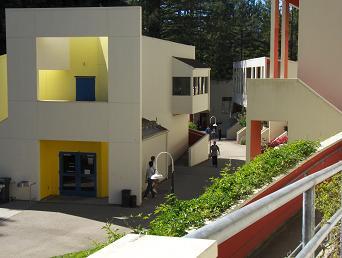

Click for full-size image
Our new series explores the history and future of university design. The first three installments detail key moments in university design history. The fourth and final installment discusses current trends in the field.
Last week, we took a look at two early American universities. This week, we’ll explore four innovative models of higher education from the 20th and 21st century.
Norwich -- 1963
 “We have recognized that students' ways of living are changing, that there is a deep desire to relax the enforced formalities of the college hall of residence.” – Denys Lasdun
“We have recognized that students' ways of living are changing, that there is a deep desire to relax the enforced formalities of the college hall of residence.” – Denys Lasdun
University architects have traditionally looked to the past to inform their designs. James Gamble Rogers, for instance, reportedly splashed acid on the stone walls of buildings he designed for Yale to simulate the effects of aging. But, when Denys Lasdun set out to build the University of East Anglia, he aimed to find a modern form for the school.
The result was a forward-looking campus in the of-the-moment Brutalist style. Students live in stacks of terraced dorms called ziggurats. Each dormitory building features a shared kitchen-and-breakfast-room where students gather and socialize. Lasdun’s Teaching Block – which contains all the classrooms and libraries – is a short five minute walk from the residence halls. He hoped that placing all the departments in the same building would foster cross-disciplinary learning and innovation.
Staffordshire -- 1966
 “Higher education and further education should become a major a major industrial undertaking, not a service run by gentlemen for the few.” – Cedric Price
“Higher education and further education should become a major a major industrial undertaking, not a service run by gentlemen for the few.” – Cedric Price
Cedric Price’s unbuilt Potteries Thinkbelt proposed an ambitious new form for the university. Price planned to revitalize an abandoned rail network by converting train carriages into classrooms. These mobile lecture halls would pick students and transport them to model factories and demonstration labs. To house students, he designed four types of modular homes which could be easily moved by cranes as the needs of the university changed.
He hoped his university would spur industrial revitalization in the area. Stressing applied rather than abstract learning, students at Potteries Thinkbelt would work with new discoveries in nearby factories. Price suggested that students should earn a salary rather than be charged tuition because they performed work that society deemed valuable.
Santa Cruz -- 1966

“It is a college in search of dialogue, an attempt through sight and association to create a highly personal and involving sense of place.” -- Paul Heyer
Architects Charles Moore and William Turnbull designed Kresge College for University of California at Santa Cruz in 1971. Turning away from the quiet sophistication of typical college campuses, Moore and Turnbull opted to create a more playful campus.
The design was based on an Italian hill town. Narrow, winding streets cut through the center of campus. Students live in irregularly shaped dorms that each feature their own balcony. Vibrant colors create a sense of energy and activity. Students congregate in a central piazza designed to social interaction. In the piazza, Moore and Turnbell built what they believed were modern community centers for students: a telephone booth and a laundromat.
Tokyo -- 2008

“Unlike a traditional, horizontally laid out school, we have designed a high-rise vertical campus that can hold approximately 10,000 students.” – Tange Associates
Completed in 2008, Mode Gakuen Cocoon Tower is the second tallest educational building in the world, surpassed only by the State University of Moscow’s Main Building. Designed by Tange Associates, the tower encompasses three schools and accommodates 10,000 students.
Each floor features three classrooms radiating from a central core. Three-story student lounges foster a sense of community and interaction between the students. The building’s distinct cocoon shape is meant to suggest the transformative power of education.
Photography credits:
Kresge College by MaryLieth - Santa Cruz Wiki, CC BY 3.0, https://commons.wikimedia.org/w/index.php?curid=3815727
Mode Gakuen Cocoon Tower by Wiiii, CC BY-SA 3.0, https://commons.wikimedia.org/w/index.php?curid=4998510
View full entryClick for full-size imageOur new series explores the history and future of university design. The first three installments detail key moments in university design history. The fourth and final installment discusses current trends in the field.Last week, we took a look at three early universities... View full entry
Click for full size imageOur new series explores the history and future of university design. The first three installments detail key moments in university design history. The fourth and final installment discusses current trends in the field.Athens – c. 380 BCE“I am going, I said, from the... View full entry
Exploring current design trends and their history.